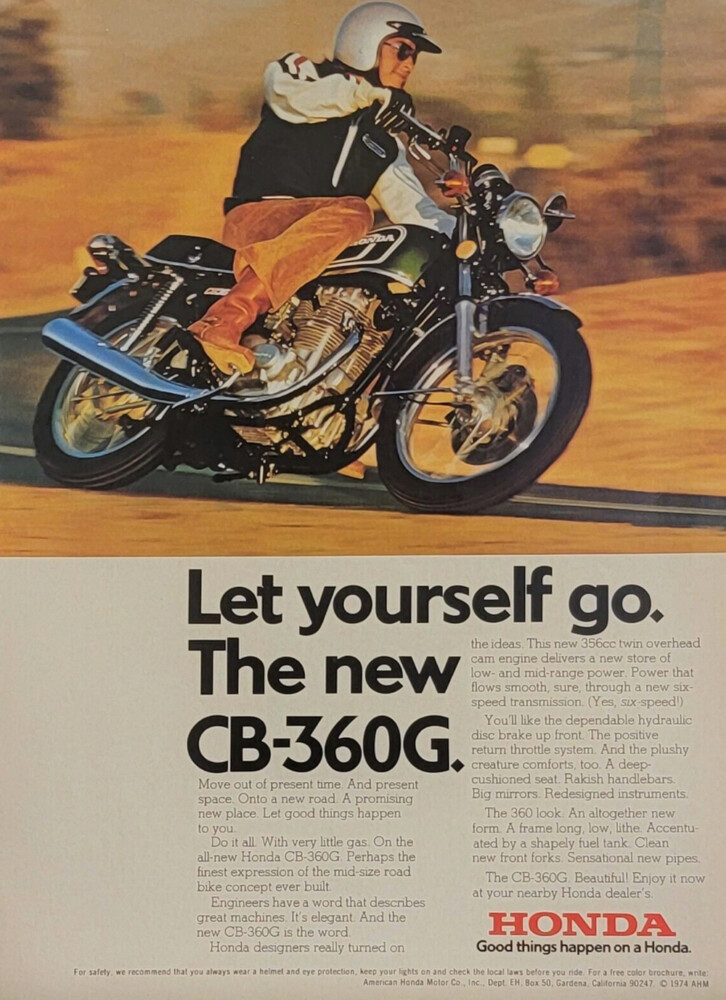| January 12, 2025
Cycle News Archives
COLUMN
The 1974 Honda CB-360 Was Proof That New Isn’t Always Better
By Kent Taylor
“Being newer,” read the Cycle News headline, “is not always being better.” The year was 1973, and the newer machine was Honda’s 1974 CB-360, the replacement model for the company’s venerable CB-350. Released in 1968, the 350 was not only one of Honda’s best-selling machines, it was also one of the most popular street bikes of all time. So, why mess with a proven formula? If it ain’t broke, well, it ain’t broke!
But Honda didn’t become number one by following the advice of the proletariat and the nifty 350 was retired and replaced with the CB-360 (and CB-360G, with a front disc brake). Gone were the covered forks and shocks. The straight, flat mufflers of the old days were now sporting a racy upswept look. The tank was restyled, and the new motor was punched out to 356 cubic centimeters, 31cc more than the 325cc of the old 350.
 Our 1974 Honda CB-360 test bike. No need to be afraid of the cops on this bike.
Our 1974 Honda CB-360 test bike. No need to be afraid of the cops on this bike.
What could be wrong with any of these improvements? Viewed as parts, and on paper, absolutely nothing. But motorcycles are the sum of their parts, and in the matter of the new Honda, all of the pieces didn’t add up to a better motorcycle.
“The CB-360…contradicts itself,” wrote CN in the November 13, 1973, issue. The test continued with the staff chiding Honda for the 360’s six-speed gearbox, which was “nothing more than a gimmick. You don’t need six speeds. You’d manage splendidly with five; four would be okay. Six speeds are to be coupled to peaky, powerful, performance-oriented engines. The Honda CB-360 powerplant is none of these.” The new machine gave new meaning to the term “sluggish,” with the staff claiming that it was a drag-race loser to every bike above 200cc.
Alas, this might be the one area where Honda’s engineers may have all been on the same page: a gutless engine hasn’t earned the right to be cradled in a beefy frame and a punchless powerband isn’t worth the extra millimeters of forking material. This Honda was a flexi-flyer! According to the testing team at Cycle News, the Honda bent, shimmied, gyrated and wiggled like Gumby on a hot plate. “The frame will flex, and both wheels get out of line at times.” A new (low) bar for frame flex!
 In 1975, the Honda CB-360 was updated with a front disc brake.
In 1975, the Honda CB-360 was updated with a front disc brake.
Numerous backhanded compliments were sprinkled throughout the story. “The frame doesn’t get a chance to flex too much,” wrote CN, “because of the horrible suspension, particularly at the rear…everyone who rode the bike compared the shocks to pogo stocks.” The staff conceded that the springs did provide a somewhat comfortable ride while going in a straight line on the freeway, but that good feeling disappeared, along with the damping when the bike was pitched into a corner because “the shocks don’t work in corners.”
In summation, the powerplant didn’t make enough juice to overly tax the frame, which flexed too much to allow the poor shocks to do their job. That takes us down to the tires, which were so hard that the word “rubber” almost seems like a misnomer. “You could lock it [the rear tire] up while coming to a stop and leave no visible rubber on the road. That’s a hard tire.” The Honda would also keep its pilot in white-knuckle mode when it wandered over to the freeway rain grooves, where the staff noted that it behaved as badly as any street bike they had ridden.
Did the CB-360 have any redeeming qualities? Well, fuel mileage was a big deal in the 1970s and this Honda never got below 45 mpg; on occasion, it would stretch that to 55 mpg. The crew logged over one thousand miles on the Honda, so they had plenty of opportunities to track fuel consumption. The bike did vibrate a little, but the crew compensated by both wearing heavier boots and occasionally resting their feet on the buddy pegs! Also in the plus column was the saddle, which was reasonably comfortable.
That was about all of the good news, however, and the crew bemoaned the fact that the clutch suffered with an adjustment issue, a problem that its predecessor, the CB-350 also brought to its owner. The Honda inexplicably burned a quart of motor oil during its 1000-mile date with the magazine, even though there were no visible leaks. The tool kit, while likely superior to today’s offerings, was seen as insufficient, and the Phillips (maybe JIS) screwdriver nicely rounded out the tops of several of the screws on the bike.
 This photo’s caption read: You have to work to be smooth. We weren’t impressed with the CB-360, yet the previous CB-350 was Honda’s best-selling model.
This photo’s caption read: You have to work to be smooth. We weren’t impressed with the CB-360, yet the previous CB-350 was Honda’s best-selling model.
The Cycle News staff asked themselves why Honda would even build such a bike. The old 350, it seemed, was filling a niche. There was a market for a mild-mannered motorcycle, and the CB-350, while perhaps uninspiring, was getting the job done. The 360, however, represented Honda’s effort to take those riders to a higher level. Magazine ads implored them to “move out of the present time. And present space. Onto a new road. Let good things happen to you.” Honda wanted 350 riders to “let yourself go” and move on to the future. Newer? No question. Better? Questions! CN
